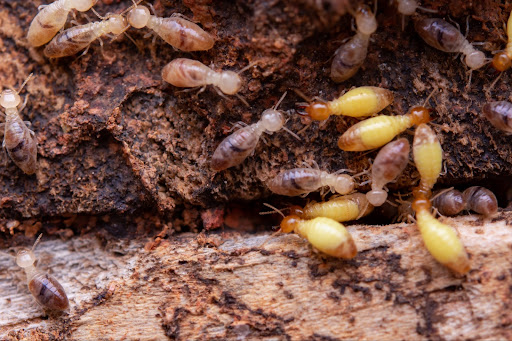Termites are often called the “silent destroyers” because of their remarkable ability to chew through wood flooring, and even wallpaper undetected. For homeowners and property managers, the threat posed by these pests can lead to significant structure damage from termites, resulting in costly repairs. At Hopper Pest & Termite, we understand the urgency of identifying and addressing termite problems before they escalate. This blog aims to shed light on the types of structural damage caused by termites and how early detection and professional intervention can save your property and your wallet.
Understanding Termite Behavior
Termites are social insects that feed on cellulose, primarily found in wood. They live in colonies that can range from a few thousand to several million individuals. These pests are particularly dangerous because they can destroy the internal structure of buildings without obvious signs of damage. Their ability to remain concealed often allows them to cause extensive damage before they are even detected, making early identification crucial.
Types of Termites
- Subterranean Termites: These termites build their colonies underground and create mud tubes to access food sources above ground. They are responsible for the majority of termite damage in the United States. Their mud tubes protect them from predators and help maintain a humid environment, critical for their survival.
- Drywood Termites: Unlike their subterranean cousins, drywood termites live within the wood they consume and do not require contact with the soil. They often infest attic spaces and can cause significant damage to roof timbers and wall supports. These termites are particularly challenging to detect as they do not create mud tubes and can remain hidden within the wood for years.
- Dampwood Termites: These termites prefer moist and decaying wood, typically found in logs, stumps, and dead trees. Homes with water damage are particularly susceptible to dampwood termite infestations. These termites are larger than their counterparts and can exacerbate the deterioration of already weakened structures.
Recognizing Signs of Termite Damage
Early detection is crucial in preventing severe termite damage. Here are key indicators that your property might be at risk:
- Mud Tubes: These pencil-sized tunnels near the base of the property are a major sign of subterranean termites.
- Wood Damage: Wood that sounds hollow when tapped or that is crumbling is likely infested by termites.
- Frass: Drywood termites produce wood-colored droppings as they eat through infested wood.
- Swarmers: The presence of winged termites or discarded wings inside the home typically indicate an active termite infestation. Finding swarmers inside your home often means the infestation is well-established and may require immediate professional attention.
Preventative Measures
Preventing terming damage involves regular inspections and addressing conditions that attract termites:
- Reduce Moisture: Repair leaking faucets, water pipes, and AC units that may cause excess moisture.
- Clear Wood from Foundation: Keep firewood, lumber, or paper away from the foundation or crawl space.
- Regular Inspections: Schedule annual inspections with professionals to catch early signs of termite activity. It is also beneficial to eliminate any soil-to-wood contact around your property, which can serve as an easy pathway for termites.
Professional Termite Control
DIY solutions are rarely effective against termite infestations due to the hidden nature of their colonies. Professional pest control services utilize advanced techniques and materials to thoroughly eliminate termites and prevent future infestations. At Hopper Termite & Pest, we use environmentally safe and highly effective methods to ensure that your property remains termite-free.
Contact Hopper Pest & Termite Today
At Hopper Pest & Termite, protecting your property from termites is our top priority. Our experienced team is equipped to provide comprehensive termite control and pest control services, tackling everything from ants and bed bugs to rodents and wildlife. With offices in Springdale and Mountain Home, we are ready to assist you in safeguarding your home against pests. Contact our Springdale office at (479) 750-4070 or our Mountain Home office at (870) 435-4122 today. Remember, the cost of prevention and early treatment is always less than the expense of repairing termite damage. Contact us today for a consultation and ensure your property is termite-free!


Recent Comments